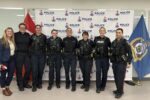Families learn First Nations culture first-hand
By Amanda Monahan
An evening of Mohawk language, music and a harvest feast brought families together for an evening to learn about First Nations culture.
Lennox & Addington Resources for Children hosted an event last week, informing parents and their children about First Nations heritage.
A Mohawk prayer recited by Sarah Brown from the Ontario Native Women’s Association opened up the dinner ceremony of a traditional harvest feast of Three Sister soup, bannock bread and corn on the cob.
The Aboriginal Family Literacy circle came up with the event to bring more awareness of aboriginal culture and sensitivity to the surrounding communities.
Brown said it’s important to teach others about First Nations people to get people talking.
“[To think about] the history and the culture and help children to understand and realize we’re all the same really but we have different beliefs and we have different languages and we have different morals.” she said
“To have an understanding of our people so that they can be more sensitive to us and to teach their children to be more aware of the difference not even just our culture but all cultures.”
Betty Maracle (Katsitsiase), the elder, agreed.
“It’s kind of hard to respect one’s culture from the heart if they don’t know anything about it. You can respect one but it’s not the same when you understand really who they are.” said Maracle.
After the harvest feast, everyone gathered around Maracle to hear the story of the Corn Husk Doll. She used fabric photos to help illustrate the story, which had a strong message.
“The moral of the story is about being humble and about putting other people’s needs before your own and not to be vain.” said Brown.
“We should never be conceited or self centered.” said Maracle.
Maracle played an important role Thursday night; she wasn’t just the elder or the storyteller but also acted as the grandmother to roughly 12 children.
”Doesn’t matter if they are our people or where they come from because I’m close to a lot of children all over the world,” she said.
“I’ve travelled all over and I’ve met all kinds of indigenous people, and it’s really something because when you meet other indigenous people and you connect with people that don’t understand their own culture but you connect with them in such a way because we all have something in common.”
The rest of the evening had the adults and children separated for their designated activities. The children had the task of creating a wordless book to remind them of the message in the Corn Husk Doll and the adults created a card game to teach them the Mohawk language.
Napanee was the host of the second Come Walk in My Moccasins with the first taking place in Belleville. Brown said it took around seven to eight months to organize.
“It’s been a lot of planning and trying to figure out what it is we want it to look like and then trying to get the right people involved to help out. It’s been a long process but it’s been really good, we’ve been able to get funding from two different counties so that’s why we decided to hold it in Belleville as well as Napanee.” she said.
Brown hopes the success and positive response from the first two will lead to more in the future.
 Print This Post
Print This Post






